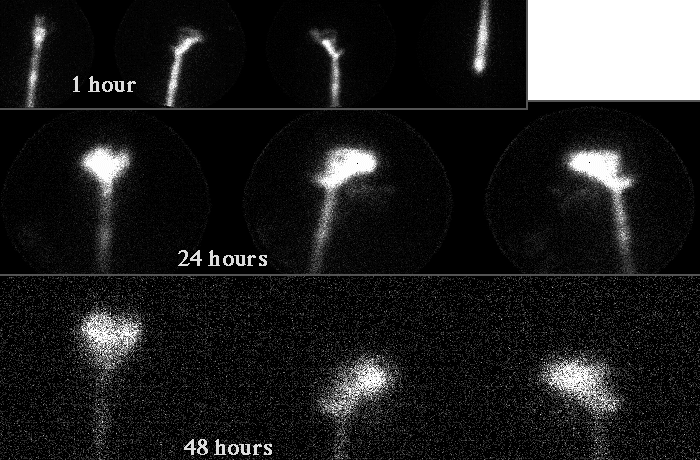Case Author(s): David A. Hillier, M.D., Ph.D. and Jerold Wallis, M.D. , . Rating: #D3, #Q3
Diagnosis: CSF leak
Brief history:
65 year-old woman status post resection of olfactory groove meningioma.
Images:

Cisternogram
View main image(ci) in a separate image viewer
View second image(ci).
Cisternogram, quantitative data.
View third image(ct).
CT and MRI
Full history/Diagnosis is available below
Diagnosis: CSF leak
Full history:
65 year-old woman with history of a 6-cm olfactory groove meningioma, status-post resection one month earlier. She now presents with clear, watery, rhinorrea of both nares. She awakens at night with cough. She denies headaches.
Radiopharmaceutical:
544 uCi In-111 DTPA by lumbar subarachnoid injection
Findings:
1. Radionuclide cisternogram:
- Small amount of activity at 5 hours, and a larger amount at 24 hours, in posterior nasopharynx.
- Moderate amount of activity in the colon at 24 hours
on abdominal images (not shown), representing swallowed activity.
- No progression of activity over convexity.
- Pledget data: (see figure 2 above)
2. MRI of the brain:
- Two cystic structures within the bilateral temporal lobes, possibly representing communication with the nasal sinuses.
3. Computed tomography of head:
- Intracranial air.
- Possible defect anterior to the right anterior clinoid with communication to the left sphenoid sinus.
4. Cerebral angiogram (1 week prior to the CT below, not shown):
- Large anterior cranial fossa mass
5. Computed tomography of brain (1 month earlier, not shown):
- Postoperative changes from frontal craniotomy.
Discussion:
After cisternography, there will always be a small, but quite
variable, amount of In-111 DTPA in the plasma. Some of the plasma
activity will be excreted into the mucosal cavities. Therefore, it
is essential to compare the pledget data with the plasma data, after
weighing the pledgets so that equal weights of plasma and nasal fluid
can be compared. After normalization for weight, the
exact ratio depends on a number of factors, including the timing of
the pledget placement and removal with respect to the injection and
plasma sampling.
However, a ratio greater than 3 is suggestive of leak.
In most positive cases, the ratio is much larger than this.
Careful placement and labeling of the pledgets can help determine
the site of the leak. In this case, the ratio is > 90 for the left
lower pledget.
Differential Diagnosis List
The faint focus of uptake in the nasopharynx, diffuse colonic
activity (due to swallowing tracer) and the pledget data are diagnostic
of a CSF leak. Extravasation of the dose would result in mild diffuse soft tissue background activity and renal uptake, but not focal nasopharyngeal or colonic activity.
ACR Codes and Keywords:
References and General Discussion of Cisternography (Anatomic field:Skull and Contents, Category:Misc)
Search for similar cases.
Edit this case
Add comments about this case
Read comments about this case
Return to the Teaching File home page.
Case number: ci004
Copyright by Wash U MO

